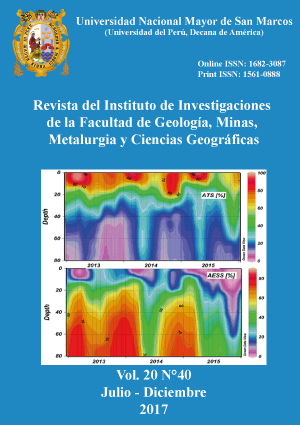Lead Contaminated Soils in the city of La Oroya-JUNIN, and its impact on the quality of the waters of the Mantaro river
DOI:
https://doi.org/10.15381/iigeo.v20i40.14389Keywords:
Lead Contaminated Soil, impact, water qualityAbstract
This research is in response to the problem of pollution generated by the presence of the La Oroya smelter, whose activities resulted in lead contamination of air and soil in La Oroya for more than 90 years. For environmental and financial problems, Doe Run Peru Smelter current owner, has ceased operations since 2009, however persist environmental liabilities.
As a result of the investigation it was found that the soils of the city of La Oroya Antigua this against the Metallurgical Complex is impacted with lead reaching as high values in some specific cases exceed 9000 mg / kg. surpassing all sense the Quality Standard Peruvian land for housing and commercial, industrial and extractive soil are 140 mg / kg and 1200 mg / kg. respectively.
The lead content in the water of the river Mantaro reaches maximum values of 1 mg Pb / L in the adjacent slag deposit Huanchan area after heavy rainfall, indicating that there is impact of soil to the river , which it would be impossible life in the aquatic environment and the Water Quality Standard Peruano is 1 ug Pb / L. Due to the high dilution capacity of the river by its high flow, the contents of lead in the river down to near normal, however environmental damage occurs each time the rains are presented. La Oroya needs urgent soil remediation to be considered suitable for housing and for the river regains its aquatic life capacity, and / or is suitable for irrigation.
From this research it is concluded that La Oroya needs urgent soil remediation to be considered suitable for housing, and that the river can once again find their capacity to aquatic life, and / or is suitable for irrigation.
Downloads
Published
Issue
Section
License
Copyright (c) 2017 Siles Arce, Marilú Calderón

This work is licensed under a Creative Commons Attribution-NonCommercial-ShareAlike 4.0 International License.
AUTHORS RETAIN THEIR RIGHTS:
a. Authors retain their trade mark rights and patent, and also on any process or procedure described in the article.
b. Authors retain their right to share, copy, distribute, perform and publicly communicate their article (eg, to place their article in an institutional repository or publish it in a book), with an acknowledgment of its initial publication in the Rev. Inst. investig. Fac. minas metal cienc. geogr.
c. Authors retain theirs right to make a subsequent publication of their work, to use the article or any part thereof (eg a compilation of his papers, lecture notes, thesis, or a book), always indicating the source of publication (the originator of the work, journal, volume, number and date).























